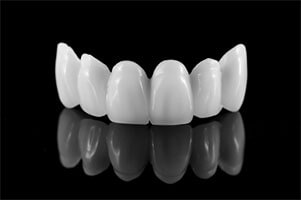Dental Crowns
 Dental crowns are natural-looking, tooth-shaped caps used to cover a damaged or missing tooth in order to restore a full and beautiful smile. These caps are cemented into place to provide both strong and visibly appealing replacements for natural teeth. Crowns are usually necessary when the tooth is broken down to the point where a filling will not be effective.
Dental crowns are natural-looking, tooth-shaped caps used to cover a damaged or missing tooth in order to restore a full and beautiful smile. These caps are cemented into place to provide both strong and visibly appealing replacements for natural teeth. Crowns are usually necessary when the tooth is broken down to the point where a filling will not be effective.
A dental crown can be used for various reasons, including covering discolored or misshapen teeth, and in conjunction with bridges and dental implants. Other benefits of dental crowns may include:
- Covering and supporting a tooth with a large filling
- Restoring a broken tooth
There are several different methods of crown restoration, each using a different crown material. Different types of material used for crowns include metal, porcelain, ceramic and resin. These materials may also be used in combination.
The Dental Crown Procedure
The dental crown process takes place in two phases. During the first appointment, the area around the tooth is numbed with a local anesthetic. The tooth is then prepared by being filed or reshaped so that the crown will fit securely and comfortably. After the tooth is prepared, an impression is made of the teeth and gums using a paste or putty. The impression is sent to a laboratory where a custom crown will be created. This process usually takes between 2 and 3 weeks. During this time, the patient is given a temporary dental crown until the permanent crown is ready.
During the second appointment, the new crown is inspected for proper fit and accurate color. The temporary crown is then removed and the new one is cemented onto the tooth.
With proper oral hygiene, dental crowns can last from 5 to 15 years. While dental crowns are most often extremely effective, they are not always appropriate for every patient.
Dental Bridges
Dental bridges are natural-looking tooth replacements that help maintain facial structure, reduce stress on the jaw and fill in the gaps caused by missing teeth. Bridges may be removable or may be fixed by cement to the existing teeth.
A dental bridge can be used to:
- Restore the patient’s original smile
- Reduce the risk of gum disease
- Restore the ability to bite and chew
- Improve speech
- Prevent the remaining teeth from drifting out of position
Types of Dental Bridges
There are three main types of bridges:
Traditional bridges – Also known as fixed bridges, traditional bridges are used to replace missing teeth.
Resin-bonded bridges – Also known as Maryland-bonded bridges, resin-bonded bridges are primarily used for the front teeth.
Cantilever bridges – Cantilever bridges are used in areas of the mouth under low stress, such as the back teeth.
Dental Bridge Procedure
Before creating a bridge, the adjacent teeth must be prepared. This involves removing some of the enamel to allow room for the crown to be placed over them. Impressions of the teeth are then made and sent to a laboratory so a bridge, pontic or artificial tooth, and crown can be created to fit the unique configuration of the patient’s mouth. This may take 2 to 3 weeks. While the bridge is being made, the patient will be given a temporary dental bridge to protect the exposed teeth and gums. On the next dental visit, the temporary bridge will be removed and replaced with the new, permanent bridge. The dentist will make sure the bridge fits properly and then cement it in place.
With good oral hygiene, a dental bridge can last from 5 to 15 years, sometimes longer.
